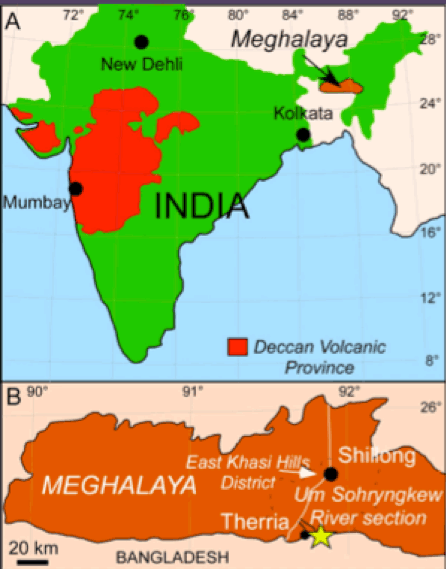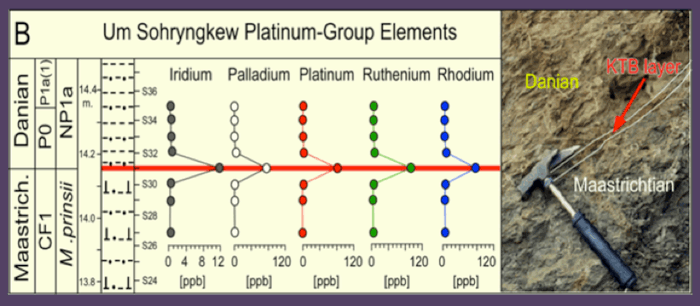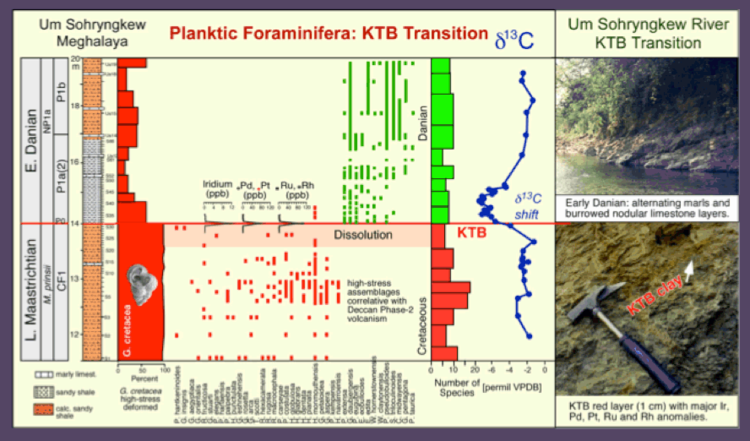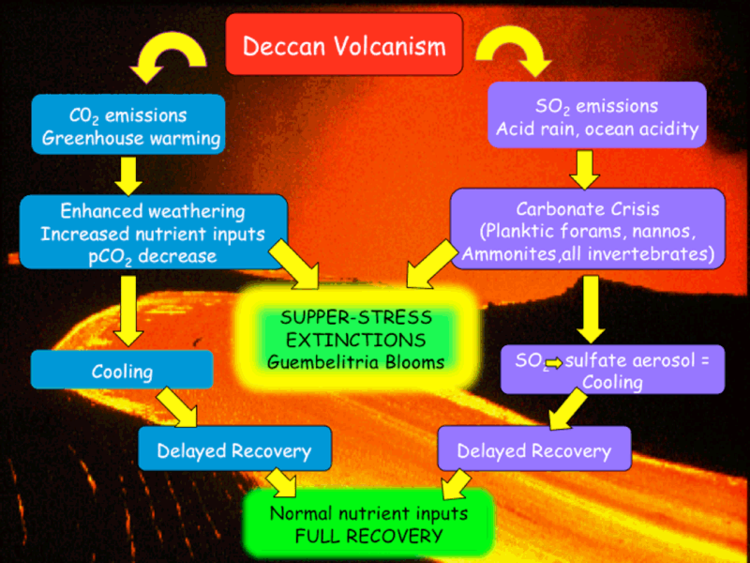
Fig. 29. Location of the Um Sohryngkew section of Meghalaya. This is the most complete KTB section in India. From Gertsch et al., 2011.
In Meghalaya, one of the most complete KTB sequences worldwide was recovered along the Um Sohryngkew River, which at KTB time was located about 800-1000 km from the main Deccan volcanic province (Fig. 29). This section provides critically important information on the effects of Deccan volcanism at 1000 km distance from the volcanic province. The information gained from this locality shows that the Deccan catastrophe was severe and caused near total devastation long before the final phase at the KTB mass extinction.

Figure 30. Platinum Group Elements (PGEs) across the KTB transition at Meghalaya, 1000 km from the main Deccan province. Maximum concentrations in a thin red clay layer. Ir and other PGEs are among the highest recorded worldwide. From Gertsch et al., 2011.
Platinum Group Elements (PGEs) across the KTB transition quantify Ir, Pd, Pt, Rh and Ru concentrations (Fig. 30). All PGEs show similar patterns with low concentrations in the upper Maastrichtian and lower Danian, and peak values in the KTB red layer and background concentrations above and below. Bhandari et al. (1993, 1994) recorded similar results suggesting an extraterrestrial source. However, the large PGE anomalies restricted to the thin clay layer indicates highly reduced sedimentation and hence concentration of MEs, TEs and PGEs over time (Donovan et al., 1988; Bruns et al., 1997). This suggests strongly condensed (redox) sedimentation linked to a rapid sea-level rise culminating in the maximum flooding surface at or near the KTB.
Biostratigraphy & Mass Extinction Pattern

Fig. 31. Biostratigraphy, species ranges, blooms of the disaster opportunist Guembelitria cretacea, PGEs and carbon and oxygen isotopes across the KTB transition at Um Sohryngkew, Meghalaya. Note the high stress conditions below the KTB correlate to the main Phase-2 Deccan eruptions. From Gertsch et al., 2011.
The Um Sohryngkew section contains one of the most complete KTB transitions worldwide and comparable to the El Kef, Tunisia, stratotype section and point (GSSP) (Cowie et al., 1989; Keller et al., 1995; Remane et al., 1999). As at El Kef the KTB is identified by the mass extinction of planktic foraminifera followed by the first appearances of Danian species in zones P0 and P1a (e.g., Parvularugoglobigerina extensa, P. eugubina, Woodringina hornerstownensis, Globoconusa daubjergensis; Keller et al., 1995, 2002; Molina et al., 2006) (Fig. 31). Also present are the same three KTB-supporting criteria, the negative δ13C shift, the Ir anomaly (12ppb) and other PGEs in a thin KTB red layer (Fig. 29). The KTB δ13C excursion at the Um Sohryngkew section shows the same trend as in the most complete and expanded KTB sequences in Tunisia and Texas (Keller et al., 2002, 2009a). This section is particularly important in that it provides critical information on the environmental and biological effects of Deccan volcanism in a marine environment that was within 1000 km of the volcanic activity.
The mass extinction pattern differs from the deep-sea record by its lower diversity (24 species as compared with over 30 in comparable shallow environments, Keller and Abramovich, 2009), the rare, sporadic pre-KTB species occurrences within the 2 m below the KTB, and blooms (> 95%) of the disaster opportunist Guembelitria cretacea (Fig. 30). These faunal assemblages reflect supper-stressed environmental conditions at the time of Deccan phase-2 eruptions. Such high Guembelitria blooms are best known from the aftermath of the mass extinction in the earliest Danian, but they have also been observed below the KTB (zone CF1) in sections throughout the Tethys, such as Bulgaria, Israel, Sinai, Egypt, Texas and in the volcanically active Ninetyeast Ridge (reviews in Pardo and Keller, 2008; Keller and Abramovich, 2009).
In the earliest Danian at Um Sohryngkew, normal low diversity assemblages evolved with the first index species, Parvularugoglobigerina extensa and P. eugubina present at 10 cm and 20 cm, respectively, above the KTB red layer, marking zones P0 and P1a (Fig. 30). The first appearances of Parasubbotina pseudobulloides and Subbotina triloculinoides at 1.15 m above the KTB red layer mark the subdivision of zone P1a into subzones P1a(1) and P1a(2). The top of subzone P1a(2) is defined by the last appearance (LA) of P. eugubina at 19.8 m (Fig. 30). The presence of these early Danian biozones indicates a relatively continuous and high rate of sediment accumulation (Gertsch et al., 2011).
Summary
The Um Sohryngkew section of Meghalaya, NE India, located just 800-1000 km from the Deccan volcanic province, is not only one of the most complete KTB transitions worldwide with all KTB-defining and supporting criteria present, but also has one of the largest Ir anomalies (12 ppb) in a thin red clay layer. This Ir anomaly contains a significant component resulting from condensed sedimentation (P) and redox fluctuations. From the late Maastrichtian C29r into the early Danian, a humid climate prevailed (kaolinite: 40-60%), accompanied by major physical weathering (illite: 30-50%; detrital mineral: 50-80%). During the latest Maastrichtian, periodic acid rains (carbonate dissolution; CIA index: 70-80) associated with pulsed Deccan eruptions, and strong continental weathering resulted in mesotrophic to eutrophic waters. The resulting super-stressed environmental conditions led to the demise of nearly all planktic foraminifera and fostered blooms (> 95%) of the disaster opportunist Guembelitria cretacea. These data reveal devastating marine conditions surrounding the Deccan volcanic province during the main Phase-2 eruptions prior to the KTB which led to regionally early extinctions followed by the global extinctions at the KTB (Gertsch et al., 2011).
Deccan Gas Emissions – The Kill Effect

Figure 32. Model showing interactions between Deccan volcanism, gas emissions, ocean acidification, weathering, nutrient supply, climate warming and cooling and biological effects.
Environmental consequences of the massive Deccan eruptions were likely devastating mainly because of gas emissions, particularly SO2 and CO2. Sulfur dioxide gas released by volcanism and injected into the stratosphere forms sulfate aerosol particulates, which act to reflect incoming solar radiation and causes global cooling. Since sulfate aerosol has a short lifespan in the atmosphere, the cooling would be short-term (years to decades), unless repeated injections from volcanic eruptions replenished atmospheric sulfate aerosols and led to a runaway effect.
From Chenet et al. (2007, 2008, 2009) we know that Deccan volcanism occurred in a series of rapid, pulsed eruptions, with each of the 30 largest pulses estimated to inject up to 150 GT of SO2 gas, or the equivalent of the Chicxulub impact (e.g. 50-500 GT), over a very short time (possibly decades). By this estimate the total Deccan eruptions injected 30 to 100 times the amount of SO2 released by the Chicxulub impact.
It is not just the sheer volume of SO2 injection, but also the rapid succession of volcanic eruptions with repeated SO2 injections that would have compounded the adverse effects of SO2 leading to severe environmental consequences (e.g., cooling, acid rain, high weathering rates, high continental runoff and nutrient input into the oceans resulting in mesotrophic to eutrophic waters), preventing recovery and likely causing a run-away effect that led to extinctions.

